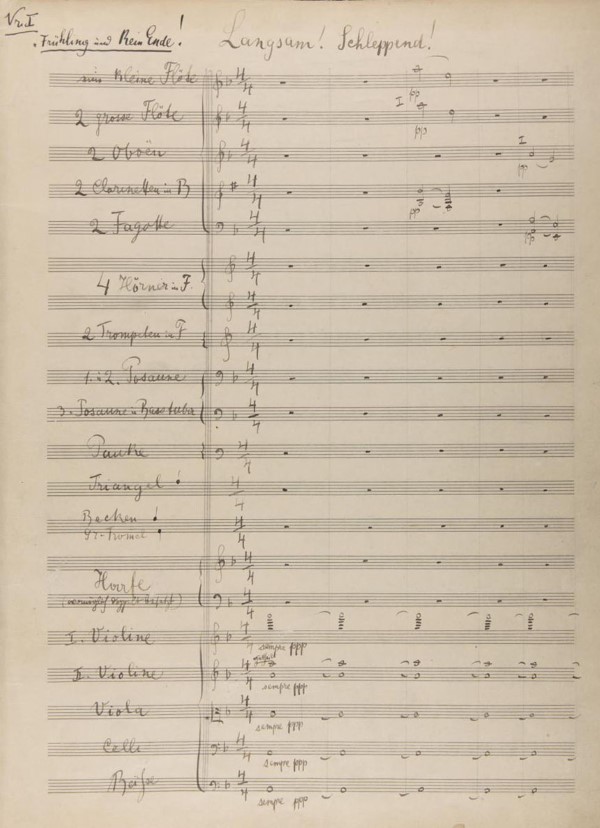Very restrained throughout, D major. The first movement is in modified sonata form, with a substantially slow introduction. The introduction begins eerily with a seven-octave drone in the strings on A, with the upper octaves being played on harmonics in the violins. A descending two-note motif is then presented by the woodwinds, and eventually establishes itself into the following repeated pattern:
This opening, in its minimalist nature and repeated descending motif, alludes to the first movement of Ludwig van Beethoven’s Symphony no. 9 in D minor. This theme is then interrupted by a fanfare-like material first presented in the clarinets, and later by offstage trumpets, indicated in the score as “In sehr weiter Entfernung aufgestellt” (At a very far distance). A slow melody is also played by the horns, and the descending two-note motif is sped up in the clarinet, imitating the sound of a cuckoo. This opening is very true to Mahler’s style, putting the emphasis on the winds, and not more traditionally on the strings.
Movement 1: Langsam, schleppend; Immer sehr gemachlich. “Frühling und Kein Ende!” (Spring without end!). “Langsam! Schleppend! (Slow! Dragging!). ‘Spring and no end’ (Introduction and Allegro Comodo). The Introduction depicts the awakening of Nature from the long sleep of winter.
The mood then lightens to mark the beginning of the exposition, and the descending fourth motif becomes the beginning of the main theme. This melodic material is recycled from the second of Mahler’s Lieder eines fahrenden Gesellen, entitled “Ging heut’ Morgen über’s Feld”.
The melody is first presented in the cellos, and passed throughout the orchestra. This melody builds in dynamic, and is eventually played by the entire brass section. A development ensues, bringing back material from the introduction, including the drone on A, the cuckoo calls in the clarinet, and the original motif. The recapitulation is marked by a new French horn fanfare, and the energy is gradually built up as before. Ultimately, the two-note motive takes over the final measures, bringing the movement to a fiery and humorous close.
Bars
- 001-009 Langsam. Schleppend (Slowly. Dragging) Wie ein Naturlaut Theme of fourths (Nature Theme).
- 009-015 Più mosso Clarinet fanfare (Awakening call).
- 016-021 Tempo I Theme of fourths.
- 022-027 Più mosso Trumpet fanfare (Awakening call).
- 028-029 Tempo I Theme of fourths.
- 030-031 Più mosso Cuckoo calls.
- 032-035 Tempo I Slow mellow horn melody.
- 036-039 Più mosso Trumpet fanfare.
- 040-043 Tempo I Slow Mellow horn melody.
- 044-046 Più mosso Trumpet fanfare and cuckoo calls.
- 047-058 Tempo I Chromatic bass motif and theme of fourths.
- 062-074 Song theme.
- 075-108 Music from third verse of 2nd song Lieder eines fahrenden Gesellen. Lied 2: Ging heut’ Morgen uber’s Feld.
- 109-135 Music from first verse of 2nd song Lieder eines fahrenden Gesellen. Lied 2: Ging heut’ Morgen uber’s Feld.
- 136-162 Final group (taken from Tirili motif).
- 163-206 Part I: New form of introduction (now with gradual retard) without use of clarinet and trumpet fanfares, with the inclusion of the Tirili motif; preparation of cello theme.
- 207-304 Part II:
- 209-220 Fanfare theme of the horns.
- 221-229 Cantabile cello theme (functioning as a secondary theme).
- 225-304 Renewed statement and development of the song motif in changing colors, including the cantabile cello theme.
- 305-357 Part III: A foreshadowing of the inferno in anticipation of a section from the Finale (bars 574-628).
- 352-357 Breakthrough: Trumpet fanfares and woodwind and horn signals.
- 358-442 Recapitulation.
- 443-450 Coda.
Embrace Everything
Listening Guide
If you have found any errors or text needing citation, please notify us by selecting that text and tap on selected text.
Related posts:
- Listening Guide – Movement 1: Langsam (Adagio) – Allegro risoluto, ma non troppo
- Listening Guide – Movement 5: Rondo-Finale. Allegro – Allegro giocoso. Frisch
- Listening Guide – Movement 2: Lied 2: Schlussszene aus Goethe’s Faust
- Listening Guide – Movement 4: Finale (Allegro moderato)
- Listening Guide – Movement 1: Langsam, schleppend; Immer sehr gemachlich
- Listening Guide – Movement 3: Scherzo. Kräftig, nicht zu schnell

